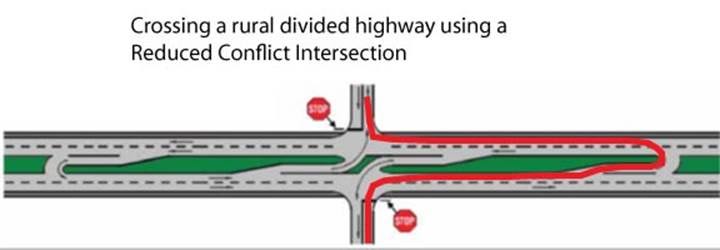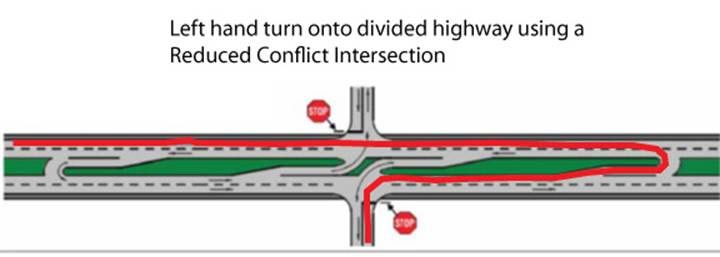
A Reduced Conflict Intersection (RCI) is an intersection that decreases fatalities and injuries caused by broadside crashes on four-lane divided highways.
It includes a geometric design that alters how left-turn movements occur. These intersections simplify decision-making for drivers and minimize the potential for higher severity crash types.
Learn more on the Federal Highway Administration website.
A Safer Alternative
RCIs have proven to be a safer alternative to a traditional roadway intersection on a four-lane highway because they eliminate or substantially reduce right-angle crashes, the crash the most responsible for fatalities and serious injuries at intersections. In fact, the installation of RCIs at similar intersections across the nation have shown a substantial decrease in fatal and serious injury crashes.
RCIs eliminate the need for motorists to cross the high-speed lanes of traffic to get to the opposing lanes. Studies done by the National Cooperative Highway Research Program show RCIs provide a significant reduction in right-angle, “far” side crashes.
In a traditional intersection there are 32 different conflict points where an accident can occur. Of those, 24 conflict points can cause serious crashes such as T-bone or right-angle crashes. A RCI can have no more than 14 possible conflict points.
How it Works
In an RCI, drivers from the side street only have to be concerned with one direction of traffic on the highway at a time. You don't need to wait for a gap in both directions to cross a major road. Traditional four-lane divided highway intersections have an elevated risk of severe right-angle crashes (commonly called "T-bone" crashes), especially for drivers attempting to cross all four lanes of traffic or turn left. At a traditional intersection, motorists from the side street need to look in both directions to cross a four-lane divided highway. Left turns require the same level of attention.

Making a Left Turn in an RCI
In a Reduced Conflict Intersection (RCI), drivers always make a right turn, followed by a U-turn. Motorists approaching divided highways from a side street are not allowed to make left turns or cross traffic; instead, they are required to turn right onto the highway and then make a U-turn at a designated median opening. This reduces potential conflict points and increases safety. Generally, the delay caused by a stop sign or signal is greater than the delay caused by the RCI.

